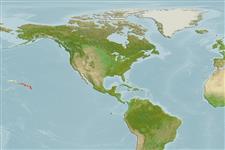Actinopterygii (ray-finned fishes) >
Perciformes (Perch-likes) >
Pomacentridae (Damselfishes) > Pomacentrinae
Etymology: Chromis: Greek, chromis = a fish, perhaps a perch (Ref. 45335). More on author: Jordan.
Environment / Climate / Range
Ecology
Marine; reef-associated; non-migratory; depth range 6 - 160 m (Ref. 9710), usually 18 - ? m (Ref. 9710). Tropical, preferred ?; 30°N - 15°N
Eastern Central Pacific: Hawaiian and Johnston islands.
Size / Weight / Age
Maturity: Lm ? range ? - ? cm
Max length : 16.0 cm SL male/unsexed; (Ref. 7247)
Dorsal
spines
(total): 14;
Dorsal
soft rays
(total): 12-14;
Anal
spines: 2;
Anal
soft rays: 12 - 14. Overall color is black. With three pupil-size white spots: one at the rear base of the dorsal fin, one at the rear base of the anal fin, and the third at mid-base of the caudal fin.
Adults form large aggregations high above the bottom in rocky areas around caves and ledges (Ref. 7247). Benthopelagic (Ref. 58302). Collected from 183 m. Spawn from December to June (Ref. 7247). Oviparous, distinct pairing during breeding (Ref. 205). Eggs are demersal and adhere to the substrate (Ref. 205). Males guard and aerate the eggs (Ref. 205).
Life cycle and mating behavior
Maturity | Reproduction | Spawning | Eggs | Fecundity | Larvae
Oviparous, distinct pairing during breeding (Ref. 205). Eggs are demersal and adhere to the substrate (Ref. 205). Males guard and aerate the eggs (Ref. 205).
Allen, G.R., 1991. Damselfishes of the world. Mergus Publishers, Melle, Germany. 271 p. (Ref. 7247)
IUCN Red List Status (Ref. 115185)
CITES (Ref. 94142)
Not Evaluated
Threat to humans
Harmless
Human uses
Aquarium: commercial
More information
ReferencesAquacultureAquaculture profileStrainsGeneticsAllele frequenciesHeritabilityDiseasesProcessingMass conversion
Tools
Special reports
Download XML
Internet sources
Estimates of some properties based on models
Phylogenetic diversity index (Ref.
82805): PD
50 = 0.5000 [Uniqueness, from 0.5 = low to 2.0 = high].
Trophic Level (Ref.
69278): 3.3 ±0.0 se; Based on diet studies.
Resilience (Ref.
69278): Medium, minimum population doubling time 1.4 - 4.4 years (Preliminary K or Fecundity.).
Vulnerability (Ref.
59153): Low to moderate vulnerability (33 of 100) .
